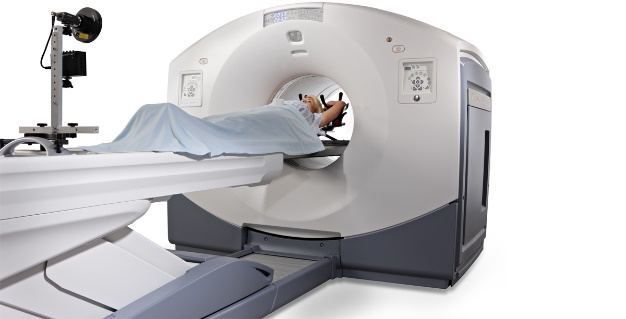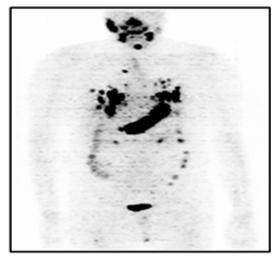I-124 dosimetry is a smart approach to assess the optimal Iodine 131 (I-131) dose to the Differentiated Thyroid Disease (DTC) patients. This assessment normally apply to the patient received I-131 more than 7.4 GBq. In principle, I-124 has the same characteristicwith I-131, but have good advantage in tumor imaging. I-124 is a radionuclide substance that is used to see the location of thyroid tumors in patients body. Generally, I-124 will go to both thyroid cancer and thyroid tissue. This helps Nuclear Medicine Physician to find where the active thyroid cancer is. This study also will ensure the optimal dose given to the patients and at the same time the organ at risk is protected.
How does I-124 work?
Patients will ask to swallow a low dose of I-124 (less than 50 MBq). I-124 will go to thyroid and to any thyroid cancer sites, where it will be absorbed. Most of the I-124 that does not absorb in thyroid tissues will leave the patient’s body through urine, stool, and other body fluids over the next 24 to 48 hours. The Iodine taken up by thyroid tissue will stay in the body for a longer time. I-124 gives off gamma rays (from positron charge), which can be seen with special PET-CT scanner as shown in Figure 1. This allows us to see residual thyroid tissue (small amounts that are left after thyroid removal surgery) and any other places where there is still thyroid cancer as shown in Figure 2. It also allows Nuclear Medicine Staff to measure the amount of I-124 in patient’s body and blood by using special instruments and every procedure will take less than five minutes. We will monitor how much it decreases over the next one week. This information is used to create a customized I-131 therapeutic dose to the patients.

Figure 1: PET-CT Imaging

Figure 2: I-124 PET-CT Imaging
What can I expect?
Normally,on that daypatients will ask to swallow a small capsule that contains a diagnostic dose of I-124(37 MBq). Nuclear Medicine staff will take radiation level from blood sample and body measurements each day for the next 5 days (normally Friday until Tuesday).
After 24 and 72 hours post I-124 ingestion, PET-CT scanner will take pictures of patient’s head, neck, and body to look for thyroid tissue and sites of thyroid cancer. To obtain these images, patients will need to lie back on the table for about 1 to 1½ hours while the machine scan throughout the body.
What are the side effects of the I-124?
Side effects from the radioactive iodine are very rare reported, but patients may have itchy skin, a rash, or hives.
On the day taken diagnostic dose of I-124
Do not eat or drink anything except water for 2 hours before the appointment. The patient’s blood will be draw for lab tests right before receive I-124 dose.
For Female patients shall inform pregnancy status before receive I-124, pregnancy test will be done if required. Women who are breastfeeding may not receive radioactive iodine, since it would be passed to the child through breast milk. It would also expose the breast tissue to extra radiation from the I-124 in the milk.
After taking diagnostic dose of I-124
Do not consume anything except water for 2 hours after I-124 ingestion. An empty stomach will ensure the body absorbs enough radioactive iodine. The respective patients will be scheduled throughout the week for blood draws, whole body measurements, and imaging sessions.
Here is the sample of daily schedule for patients who undergo I-124 dosimetry:
|
Day
|
Duration
|
Time |
Action
|
|---|---|---|---|
| Day 1 | I-124 administration |
1:00 PM
|
I-124 administer to the patient |
| After1hr I-124 administration |
2:00 PM
|
Measure radiation level from patient’s body (patients prohibited to excrete) | |
| After 2hr I-124 administration |
3:00 PM
|
Measure radiation level from blood sample and patient’s body | |
| After 4hr I-124 administration |
5:00 PM
|
Measure radiation level from blood sample and patient’s body | |
| Day 2 | After 19hr I-124 administration |
8:00 AM
|
Measure radiation level from blood sample and patient’s body |
| After 24hr I-124 administration |
1:00 PM
|
PET-CT 24hr 2D scan (10 min : 1 Bed) and 3D scan (7 min : 1 Bed) | |
| Day 3 | After 48hr I-124 administration | 1:00 PM | Measure radiation level from blood sample and patient’s body |
| Day 4 | After 72hr I-124 administration | 1:00 PM | Measure radiation level from blood sample and patient’s body |
| After 73hr I-124 administration | 2:00 PM | PET-CT 73hr 2D scan (10 min : 1 Bed) | |
| Day 5 | After 96hr I-124 administration | 9:00 AM | Measure radiation level from blood sample and patient’s body |
| 10:00 AM | PET-CT F18-FDG scanning |
I-124 Dosimetry results
A Nuclear Medicine Physician will evaluate I-124 dosimetry result from a medical physicist before proceed with I-131 therapy.
References
Jentzen, W., Hobbs, R. F., Stahl, A., Knust, J., Sgouros, G., & Bockisch, A. (2010). Pre-therapeutic 124I PET(/CT) dosimetry confirms low average absorbed doses per administered 131I activity to the salivary glands in radioiodine therapy of differentiated thyroid cancer. European Journal of Nuclear Medicine and Molecular Imaging, 37(5), 884–895.
| Last Reviewed | : | 31 October 2017 |
| Writer | : | Mohd Aminuddin bin Said |
| Accreditor | : | Mohd Hizwan bin Mohd Yahya |







